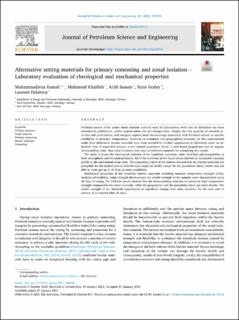| dc.contributor.author | Kamali, Mohammadreza | |
| dc.contributor.author | Khalifeh, Mahmoud | |
| dc.contributor.author | Saasen, Arild | |
| dc.contributor.author | Godøy, Rune | |
| dc.contributor.author | Delabroy, Laurent | |
| dc.date.accessioned | 2023-02-17T14:36:14Z | |
| dc.date.available | 2023-02-17T14:36:14Z | |
| dc.date.created | 2021-05-01T13:37:17Z | |
| dc.date.issued | 2021 | |
| dc.identifier.citation | Kamali, M., Khalifeh, M., Saasen, A., Godøy, R., & Delabroy, L. (2021). Alternative setting materials for primary cementing and zonal isolation–Laboratory evaluation of rheological and mechanical properties. Journal of Petroleum Science and Engineering, 201, 108455. | en_US |
| dc.identifier.issn | 0920-4105 | |
| dc.identifier.uri | https://hdl.handle.net/11250/3052056 | |
| dc.description.abstract | Portland cement is the prime zonal isolation material used in hydrocarbon wells and its utilization has been extended to geothermal, carbon sequestration and gas storage wells. Despite the vast quantity of research activities and publications, well integrity reports show shortcomings associated with Portland cement at specific conditions of pressure, temperature, chemical environment and geographical locations. In this experimental study, four alternative barrier materials have been selected for further experiments at laboratory scale: an industrial class of expansive cement, a non-cement pozzolanic slurry, a rock-based geopolymer and an organic thermosetting resin. Neat class G cement was used as reference material for comparing the results.
The study includes the rheological behavior of the candidate materials, static fluid-loss and pumpability at both atmospheric and elevated pressures. All of the materials at the liquid phase showed an acceptable viscosity profile at the operational shear rates. The consistency curve of the slurries showed that the barrier materials are pumpable for the desired period with the right-angle set (RAS), except for the pozzolanic slurry, which was not able to make gel up to 24 h at dynamic conditions.
Mechanical properties of the candidate barrier materials including uniaxial compressive strength (UCS), modulus of flexibility, sonic strength development and tensile strength of the samples were characterized up to 28 days of curing. The UCS test results showed that the thermosetting resin has an extremely high compressive strength compared to the other materials, while the geopolymer and the pozzolanic slurry are more ductile. The tensile strength of the materials experienced no significant change over time; however, for the neat class G cement, it is reduced after 28 days. | en_US |
| dc.language.iso | eng | en_US |
| dc.publisher | Elsevier | en_US |
| dc.rights | Navngivelse 4.0 Internasjonal | * |
| dc.rights.uri | http://creativecommons.org/licenses/by/4.0/deed.no | * |
| dc.title | Alternative setting materials for primary cementing and zonal isolation – Laboratory evaluation of rheological and mechanical properties | en_US |
| dc.type | Peer reviewed | en_US |
| dc.type | Journal article | en_US |
| dc.description.version | publishedVersion | en_US |
| dc.rights.holder | The authors | en_US |
| dc.subject.nsi | VDP::Teknologi: 500 | en_US |
| dc.source.journal | Journal of Petroleum Science and Engineering | en_US |
| dc.identifier.doi | 10.1016/j.petrol.2021.108455 | |
| dc.identifier.cristin | 1907580 | |
| cristin.ispublished | true | |
| cristin.fulltext | original | |
| cristin.qualitycode | 2 | |

